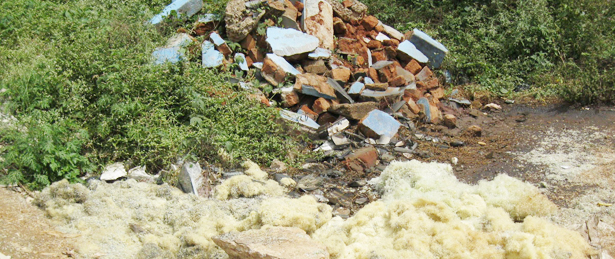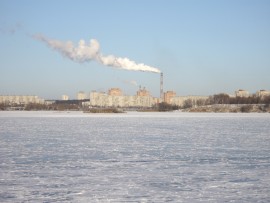Source #6
Industrial Estates
Description
Industrial estates, also known as industrial parks, are areas where infrastructure and buildings, usually built by governments, attract and support industrial activity to the zone. Typically there are roads, power, utility services, waste treatment and other services built specifically to support the industrial processes happening there, and they are often located outside of major population zones. In some circumstances, the estates may be little more then areas zoned for industrial development, with limited infrastructure. The industrial processes within these estates vary widely and the pollutants resulting from them also vary.

Industrial estates, also known as industrial parks, are areas where infrastructure and buildings, usually built by governments, attract and support industrial activity to the zone. Typically there are roads, power, utility services, waste treatment and other services built specifically to support the industrial processes happening there, and they are often located outside of major population zones. In some circumstances, the estates may be little more then areas zoned for industrial development, with limited infrastructure. The industrial processes within these estates vary widely and the pollutants resulting from them also vary.
Industrial estates are associated with over 100 of the sites in the Blacksmith Institute’s database and pollutants from them potentially affect an estimated 4 million people near these sites. Industrial estates are located all over the world and the sites are highly variable across many different countries. Currently, the Blacksmith Institute database shows that a majority of sites polluted by industrial estates are located in South Asia, mainly in India and Pakistan, although such estates are known to exist in many developing countries seeking to increase their manufacturing sector.
Exposure Pathways
Pollution at industrial estates is generally caused by a lack of appropriate waste processing infrastructure or pollution controls. Air pollution emissions, contamination of surface waters or aquifers that communities rely on for water, and improper disposal of hazardous wastes are prevalent at poorly managed and controlled estates. In addition, these polluted industrial estates are sometimes located close to population centers. Alternatively, population centers (often including squatter settlements) grow near the estates due to availability of jobs. The World Bank Group recommends that industrial estates include systems for vapor recovery, sulfur recovery, recovery of waste, recycling of wastewaters, spill prevention and hazardous chemical and waste storage. These controls would reduce VOC emissions, sulfur emissions, and the release of many toxic pollutants.[1]
Because of the high variability of activity at industrial estates, there are many ways in which pollutants can enter the environment. Industrial estates contain the types of industries that are covered elsewhere in this report, including lead smelting and processing, battery manufacturing and recycling, and chemical and product manufacturing. However, there are many additional types of industry processing that happens at industrial estates, complicating the identification, assessment, and clean up greatly. At polluted sites, general pathways for pollutants include wastewater, direct exposure to improperly disposed waste or sludge, and dust or emissions. Pathways for human exposure include inhalation of dust, dermal contact, food ingestion, and water ingestion.
Top Pollutant(s)
Blacksmith has identified lead and chromium as the top pollutants in the surveyed sites included in the Blacksmith Institute’s database. An estimated 1.3 million people are potentially at risk from lead exposure related to industrial estates and almost 1 million people are estimated to be at risk from exposure to chromium. The combined health effects from these pollutants include mild mental retardation, loss of IQ, cardiovascular problems, and lung cancer. To read more about the health effects of lead and chromium go to the health effects sections for those pollutants.
Global Burden of Disease
Blacksmith Institute estimates that industrial estates contribute a little over 1 million DALYs to the total disease burden in the 49 countries assessed. The largest contributor in this industry was lead, contributing to nearly all health risks. It should be noted that industrial estates release multiple and varied pollutants and this calculation of the burden of disease only examined known pollutants based on the Blacksmith Institute’s database information. There could potentially be a much higher impact from the cumulative impact of combined pollutants, including possible pollutants not yet defined in our site investigations. As a result, this DALY calculation is very likely an underestimate.
What is being done?
Stricter regulation by government and more technologically advanced waste treatment systems built into the estates could greatly reduce the risk of pollution from industrial estates. For example the Blacksmith Institute has worked at a site in the Kafue River Basin in the Chingola District in Zambia, which has experienced heavy pollution over the past several decades. Several industrial units, including Konkola Copper Mines, pulp and paper mills, fertilizer factories, granulation plants, and textile manufacturers, regularly disposed of industrial waste products and various bio-chemical substances, used in their mining and ore processing operations, directly into the nearby water reservoirs. In 2005, Blacksmith surveyed the polluted sites to identify and prioritize cleanup efforts. As a result, Kafue Nitrogen Chemicals, Lee Yeast, and Bata Tannery established cleaner production and waste treatment methods. The government now continuously monitors pollution streams from industrial plants.
Footnotes:
[1] “Industrial Estates.” Pollution Prevention and Abatement Handbook. World Bank Group. Washington, DC, 1998. 34 35

-
Source #1
Battery Recycling
-
Source #2
Lead Smelting
-
Source #3
Mining and Ore Processing
-
Source #4
Tanneries
-
Source #5
Industrial/Municipal Dumpsites
-
Source #6
Industrial Estates
-
Source #7
Artisanal Gold Mining
-
Source #8
Product Manufacturing
-
Source #9
Chemical Manufacturing
-
Source #10
Dye Industry
-
The Remaining Five Sources



